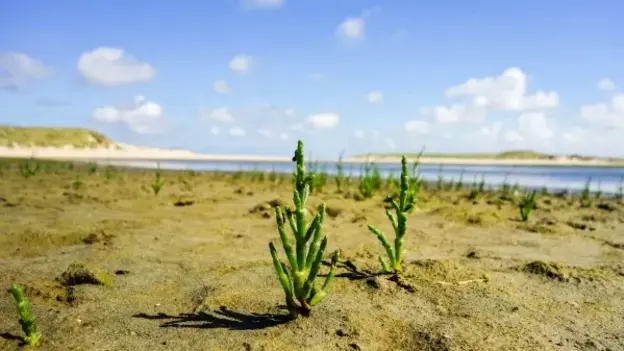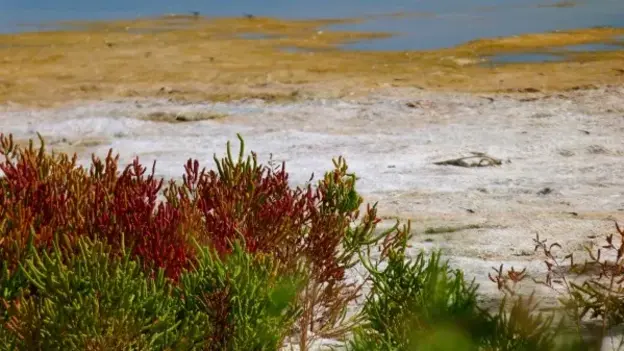Tandem Project
Saltwater Plants as Biomass for Energy Production?
Halophytes are able to survive and to reproduce in environments with high salinity levels. It is time to spotlight these tough survival artists. AGYA members Ahmed Debez and Skander Elleuche invited their fellow members Jan Friesen and Carsten Montzka to take on this mission and investigated if halophytes could constitute a valuable resource in the bioenergy sector.
Halophytes are obviously plant outsiders - what makes them so attractive to four researchers of different disciplines?
Carsten Montzka:
The topic “Halophytes for biofuel production” can only be addressed from an interdisciplinary angle. Within AGYA there is a wide range of scientific expertise provided by the members of our academy. We were amazed by the fact that this little outsider is a connecting element of our quite diverse research backgrounds. The topic of “Halophytes for biofuel production” is a common denominator.
How did you approach the topic from your own disciplinary backgrounds?
Carsten Montzka:
Ahmed’s expertise is biotechnology, and specifically, bio-physiological adaptions. His contribution started by providing key information about halophyte plants.
Ahmed Debez:
Halophyte plants are native of saline ecosystems, whether coastal or inland, with a particular emphasis on their salt-tolerance limits. These limits are known to vary significantly between and even within species. Therefore, I identified halophytes with bioenergy potential.
Carsten Montzka:
Jan addresses the topic from a geographer’s perspective and has focused on the global distribution of halophyte habitats.
Jan Friesen:
One major challenge is, of course, that there is a large number of different halophyte species with different characteristics regarding their regional distribution. I therefore generated maps that show the distribution of saline soils and coastal regions. I have worked closely with Carsten, who focused on saline soils and their properties.
Carsten Montzka:
In my research area–remote sensing of soil moisture for climate simulations–hydraulic soil properties are of utmost importance. However, these hydraulic characteristics are closely linked to the physical and chemical composition of the soil inherited from the sediment and modified by climatic influences. Now, Skander is a biotechnologist with an expertise in biomass degradation. He determined biocatalysts which are capable of decomposing plant materials from halophytes.
Skander Elleuche:
Since halophytes exhibit certain salt concentrations that influence further industrial processing by corrosion of a production plant and inhibition of salt sensitive enzymes, I focused on the production of biocatalysts from halophilic microbes. These bacterial and archaeal species do not only survive but also thrive in high salt environments. Their enzymes might be most suitable for halophytic plant biomass degradation.
Quick Facts about Salicornia
-
Salicornia is a halophyte and salt-tolerant plant that grows in soil or waters of high salinity.
-
It is low in sodium, rich in potassium, magnesium, calcium and iodine and contains fiber, vitamins and essential amino acids.
-
The leafless succulents store dissolved salt and many different minerals in their stems and serve as a natural source for iod.
-
Restaurant-goers can enjoy the fresh, hand-picked tips served raw, when they are crisp and piquant, or blanched as sea asparagus.
-
Oil produced from the salicornia seeds and the decomposition of halophytic plant material can be utilized for biofuel production.
How can the Arab countries and Germany benefit from the results of this research?
Ahmed Debez:
Halophytes are distributed all over the coasts of most Arab countries but are neither utilized nor recycled. Sustainable technologies that establish such processes still need to be developed.
Jan Friesen:
The discussion regarding renewable energy and especially bioenergy is currently gaining momentum. In view of plant based-energy products, there are issues that affect both the Arab world and Germany, for example, the food-versus-fuel debate in regard to bioenergy. As to the potential regions for halophyte production, those are mostly found in the Arab countries, especially in the southern Mediterranean.
Ahmed Debez:
Halophytes could play a role in sustainable biomass production in the Arab world but more interdisciplinary research is needed to identify the technically and economically feasible solutions.
- Disciplines Involved
- Biology, Environmental Studies
- Project Title
- Spotlight on Survival Artists: Saltwater Plants as Biomass for Energy Production?
- Year
- 2017
- Funding Scheme
- Tandem Project
- Countries Involved
- Germany, Tunisia





